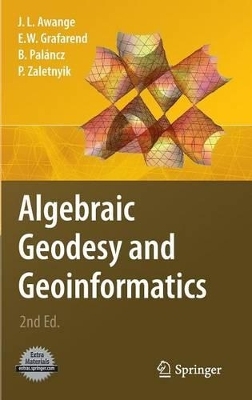Algebraic Geodesy and Geoinformatics
Seiten
2010
|
2nd ed. 2010
Springer Berlin
978-3-642-12123-4 (ISBN)
Springer Berlin
978-3-642-12123-4 (ISBN)
- Titel erscheint in neuer Auflage
- Artikel merken
The book presents modern and efficient methods for solving Geodetic and Geoinformatics algebraic problems.
While preparing and teaching ‘Introduction to Geodesy I and II’ to undergraduate students at Stuttgart University, we noticed a gap which motivated the writing of the present book: Almost every topic that we taught required some skills in algebra, and in particular, computer algebra! From positioning to transformation problems inherent in geodesy and geoinformatics, knowledge of algebra and application of computer algebra software were required. In preparing this book therefore, we have attempted to put together basic concepts of abstract algebra which underpin the techniques for solving algebraic problems. Algebraic computational algorithms useful for solving problems which require exact solutions to nonlinear systems of equations are presented and tested on various problems. Though the present book focuses mainly on the two ?elds, the concepts and techniques presented herein are nonetheless applicable to other ?elds where algebraic computational problems might be encountered. In Engineering for example, network densi?cation and robotics apply resection and intersection techniques which require algebraic solutions. Solution of nonlinear systems of equations is an indispensable task in almost all geosciences such as geodesy, geoinformatics, geophysics (just to mention but a few) as well as robotics. These equations which require exact solutions underpin the operations of ranging, resection, intersection and other techniques that are normally used. Examples of problems that require exact solutions include; • three-dimensional resection problem for determining positions and orientation of sensors, e. g., camera, theodolites, robots, scanners etc.
While preparing and teaching ‘Introduction to Geodesy I and II’ to undergraduate students at Stuttgart University, we noticed a gap which motivated the writing of the present book: Almost every topic that we taught required some skills in algebra, and in particular, computer algebra! From positioning to transformation problems inherent in geodesy and geoinformatics, knowledge of algebra and application of computer algebra software were required. In preparing this book therefore, we have attempted to put together basic concepts of abstract algebra which underpin the techniques for solving algebraic problems. Algebraic computational algorithms useful for solving problems which require exact solutions to nonlinear systems of equations are presented and tested on various problems. Though the present book focuses mainly on the two ?elds, the concepts and techniques presented herein are nonetheless applicable to other ?elds where algebraic computational problems might be encountered. In Engineering for example, network densi?cation and robotics apply resection and intersection techniques which require algebraic solutions. Solution of nonlinear systems of equations is an indispensable task in almost all geosciences such as geodesy, geoinformatics, geophysics (just to mention but a few) as well as robotics. These equations which require exact solutions underpin the operations of ranging, resection, intersection and other techniques that are normally used. Examples of problems that require exact solutions include; • three-dimensional resection problem for determining positions and orientation of sensors, e. g., camera, theodolites, robots, scanners etc.
Algebraic symbolic and numeric methods.- Basics of ring theory.- Basics of polynomial theory.- Groebner basis.- Polynomial resultants.- Linear homotpy.- Solutions of Overdetermined Systems.- Extended Newton-Raphson method.- Procrustes solution.- Applications to geodesy and geoinformatics.- LPS-GNSS orientations and vertical deflections.- Cartesian to ellipsoidal mapping.- Positioning by ranging.- Positioning by resection methods.- Positioning by intersection methods.- GNSS environmental monitoring.- Algebraic diagnosis of outliers.- Datum transformation problems.
| Zusatzinfo | XVIII, 377 p. With online files/update. |
|---|---|
| Verlagsort | Berlin |
| Sprache | englisch |
| Maße | 155 x 235 mm |
| Gewicht | 727 g |
| Themenwelt | Naturwissenschaften ► Geowissenschaften ► Geografie / Kartografie |
| Schlagworte | algebraic computations • Computer Algebra • Engineering • Geodesy • geoinformatics • GIS • Photogrammetry • Robotics • Surveying |
| ISBN-10 | 3-642-12123-3 / 3642121233 |
| ISBN-13 | 978-3-642-12123-4 / 9783642121234 |
| Zustand | Neuware |
| Haben Sie eine Frage zum Produkt? |
Mehr entdecken
aus dem Bereich
aus dem Bereich
Wasserstraßen zwischen Emmerich, Hörstel und Mainz
Media-Kombination (2023)
Kartenwerft
CHF 69,85
Media-Kombination (2018)
Cambridge University Press
CHF 52,25
Der Klassiker unter den Strategiespielen
Spiel (2023)
Laurence King Verlag
CHF 39,75




